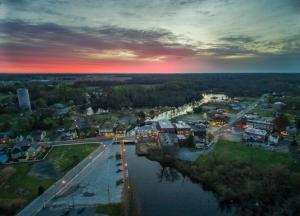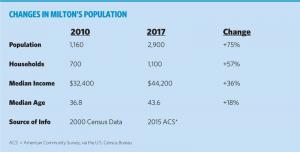Growing Milton looks to the future
A lot has changed in Milton over the past few years.
The town’s population has nearly doubled, incomes are increasing and the average age of residents is climbing.
Changes in the town’s demographics led former planning and zoning Chairman Barry Goodinson to propose a full rewrite of the town’s comprehensive plan nearly three years ago, even though a review would have sufficed.
“Most comprehensive plans are primarily written for the Office of State Planning Coordination – they’re dry, lurch all over the place, there’s no narrative arc, and it’s hard to find stuff,” Goodinson said in a recent interview as he reflected on the inspiration for the full rewrite. “We wanted this to be a document that also took into consideration the people of Milton as an audience.”
The aim was to produce a document that would actually be used and include input from Miltonians, Goodinson said. To ensure the public had a voice in the plan, Goodinson and the commissioners held more than a dozen public workshops, inviting experts from across the state to discuss everything from sea level rise to affordable housing.
“As long as that stuff makes it into the plan, I think there’s enough of the public’s good ideas and shared view for Milton to form the backbone of a really good comprehensive plan,” Goodinson said. “But it’s all about implementation. If the plan sits on the shelf and no one takes it off, then the plan is useless.”
The new draft borrows some content from its predecessor, but presents information much more clearly, with specific chapters and sections that make it easy for the average person to read.
Milton’s growing - and graying - population is reflected in calls for improved public transportation, consideration of new fire department substations at Broadkill and Harbeson, and the dire need to improve and expand drinking water infrastructure.
Because Milton’s population now exceeds 2,000 residents, a state review found the town must add chapters on affordable housing, economic development and community design. The plan now notes a need for more affordable housing and recognizes the town’s economy and employment now rely on service-based businesses rather than manufacturing and agriculture.
The plan embraces these changes; recommended implementation strategies include revitalizing the town center to promote small-scale redevelopment, secure more parking, consider a new zoning district for open space and land preservation, and increase access to biking and pedestrian trails to connect the town’s growing neighborhoods. No major changes have been made to the town’s 3,600-acre growth area maps.
Many of the challenges and goals addressed by the plan were driven by a 2015 survey of Miltonians’ visions for the town, which yielded hundreds of responses. A synopsis of more than 600 responses will be appended to the plan, which was unveiled at a November planning and zoning meeting and is available for review at Milton Town Hall.
“I think it’s going to probably be one of the better plans in the state,” said Commissioner Don Mazzeo.
But there’s still more work to be done.
The town already has spent more than $50,000 on the rewrite, mostly for engineering and technical assistance. A senior consultant from Pennoni Associates Inc. has taken the lead since Goodinson resigned from the commission in late October.
“This plan really comes from the sweat equity and work of members of this commission as well as the public,” said George Cardwell, a senior consultant with Pennoni. “In reality, it’s a road map to your future.”
Commissioners have allowed time for additional input from the town Historical Preservation Commission and Economic Development Committee before reviewing the document again and then sending it to mayor and council.
Once mayor and council approve the plan, tentatively in early 2017, the document will be sent to the Office of State Planning Coordination for review. Depending on the agency’s comments, it will then go to the General Assembly for approval before reaching the governor’s office for a final signature.
Cardwell said he expects the plan to be adopted in 2017.


























































